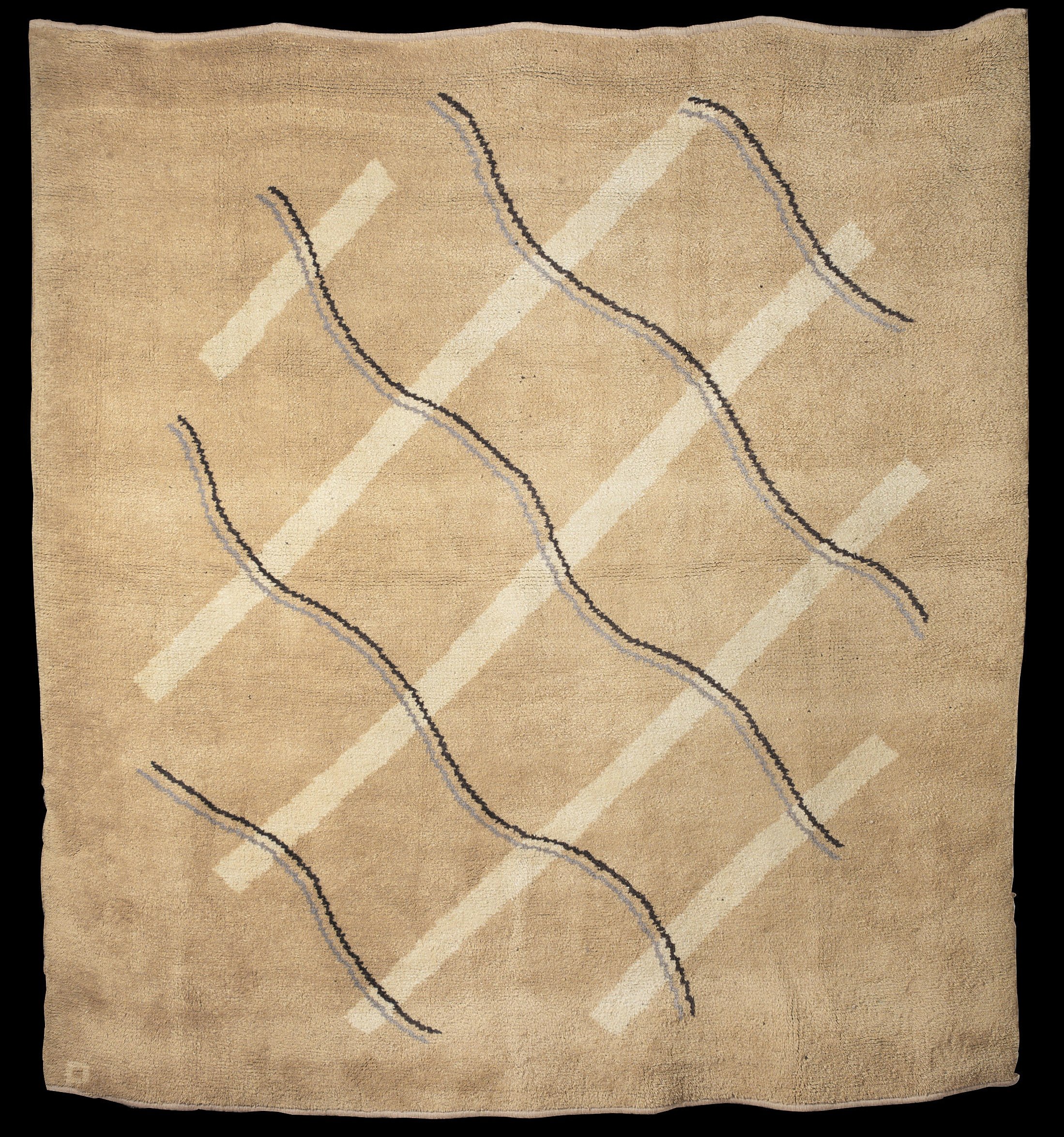MARIAN PEPLER
Forty-Five rug designed by Pepler, 1930s. Reproduced by Christopher Farr Cloth.
Marian Pepler (1904 - 1997) was a distinguished British architect and textile designer, known for her elegant rug designs for Modernist interiors. Over her 40 year career she designed many rugs for her brother-in-law’s firm Gordon Russell Ltd and consulted on architectural schemes alongside her husband Dick Russell. Design historian Nikolaus Pevsner observed that her textiles expressed “a sensitivity and a quiet perfection not surpassed anywhere in Europe”.
Pepler was born in Surrey to a liberal family interested in design. Her father, George Lionel Pepler was a town planner and architect prominent in the early 20th century. And her uncle, Hilary Pepler, founded St Dominic’s Press in Ditchling alongside Eric Gill. She studied at Croydon School of Art from 1923-24 before enrolling at London’s Architectural Association School; women were only admitted to the school in 1917, so she would have been part of a very small cohort of women on the architecture course. It’s here she met her husband-to-be Dick Russell (known professionally as R.D. Russell). As you can see, she was surrounded from a young age by several (male) design heavyweights, but she forged her own way on account of her innate talent.
Design for Forty-Five rug painted in gouache in ‘mulberry, green, blue and cream’. Image credit Gordon Russell Design Museum.
Beach hand-woven rug, c.1933. Image credit Bonhams.
Upon graduating in 1929, Pepler acquired work at Cotswolds furniture-makers Gordon Russell Ltd., whose focus was exceptional craftsmanship and democratic design. Around this time, Gordon appointed his younger brother Dick to take over the design office and Marian was asked to design rugs. I do wonder whether this assignment was made on account of her simply being a woman (textiles have long been culturally consigned to the feminine domain, whilst wood, metal and concrete claimed as ‘masculine’ pursuits, but perhaps that’s a debate for another time). Consequently she sought extra training at the London School of Weaving, where she learnt her craft.
She designed her first rug, Snowshill, for Gordon Russell in 1930 - a balanced design of rectangles, spots and crosses in calming hues of blue and fawn wool. Given her architectural know-how, she understood that the role of the rug in the modern interior was not to make a loud statement but to quietly and harmoniously unite the room.
Snowshill hand-knotted wool rug, 1930. Reproduced by Christopher Farr Cloth.
Exhibition catalogue for R.D. Russell, Marian Pepler held at the Geffrye Museum, 1983.
Dining room in Birkenhead designed by Gordon Russell, featuring hand-tufted Peru rug by Pepler, 1935. Image credit Gordon Russell Design Museum.
Pepler visited the Stockholm Exhibition of 1930, where she would have encountered the work of Swedish textile designers like Elsa Gullberg and Märta Måås-Fjetterström who were weaving rölakan rugs in soft, earthy colours and interlocking abstract forms. I think you can see the Swedish influence in Marian’s creations, although she adapted her style for a British audience, creating what Penny Sparke describes as “a peculiarly British brand of modernism”.
The three main firms that manufactured her rugs were Wilton Royal Carpet Factory, Tomkinson’s and Edinburgh Weavers - they would then either be sold directly by the manufacturer or via an upmarket retailer, such as Heal’s, Gordon Russell Ltd or Bowman’s. She had a keen eye for colour, stating that colour made up more than half of the design. It’s said she made regular factory visits to ensure the dyes were matched according to her vision (a woman after my own heart). She typically employed earthy hues of buff, tan and tobacco brown punctuated with dusty blues or acidic yellows.
It seems that Marian dipped into designing lengths of fabric for curtains and covers, but it’s surprising to me that she did not do more. Her fabrics include this cotton chenille with a herringbone and circle pattern, produced by Edinburgh Weavers and used to upholster a set of Gordon Russell dining chairs. And an earthy looking fabric named ‘Ploughland’ woven in brown and cream, pictured on the far left of this Gordon Russell brochure from 1937.
Left: Dining chair designed by W.H. Russell for Gordon Russell Ltd., upholstered with fabric by Pepler, 1934. Image credit Museum of the Home. Right: Gordon Russell brochure, 1937, featuring Ploughland fabric (far left) by Pepler. Image credit Gordon Russell Design Museum.
Marian with a kilim rug originally designed in 1932. Image credit Gordon Russell Design Museum.
After the war, Marian’s focus shifted to industrial design, consulting on architectural projects together with her husband. In 1946 she was recognised as a fellow of the Society of Industrial Artists and designed a rug for the V&A’s major Britain Can Make It exhibition the same year.
Pepler’s work has at times been overshadowed by her husband’s. In 1983, an exhibition titled R.D. Russell, Marian Pepler was held at the Geffrye Museum (now Museum of the Home) to celebrate the couple’s oeuvre. A review from the time focused heavily on Dick’s work, mentioning Marian’s “contribution” as something of an afterthought in the final paragraph. In recent years, however, her work has reached a wider audience thanks to her rugs being reproduced under license by voguish textile firm Christopher Farr Cloth. So you can now admire a Marian Pepler design on your own living room floor (if you have a few thousands pounds to spare). Much of her work is held at and celebrated by the wonderful Gordon Russell Design Museum in the Cotswolds.
FURTHER READING:
Two of a Kind: The Work of Designers Dick Russell and Marian Pepler by Ray Leigh, 2013
R.D. Russell, Marian Pepler exhibition catalogue by Rosamond Allwood & Laurie Kedrun, 1983
Carpets of the Art Deco Era by Susan Day, 2002
A Change of Direction: Gordon Russell Furniture 1930-1940 by Ray Leigh, 2017
Marian Pepler - https://architecture.arthistoryresearch.net/architects/pepler-marian
British Textile Designers Today by HG Hayes Marshall, 1939










